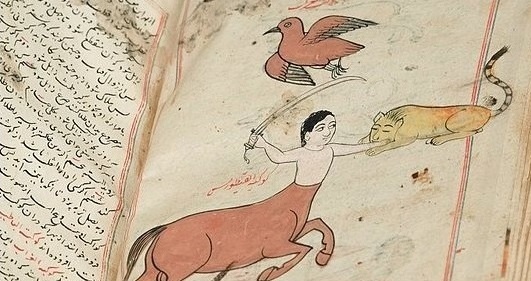
This is an illustration from
Al-Qazwīnī’s
Ajā’īb al-makhlūqāt wa gharā’ib al-mawjūdāt, a Persian translation
published in 19th century India. A centaur named Firenze eludes to Voldemort's return in
Book 1,
Harry Potter and the Sorcerer's Stone.
This page is intended to be an informal introduction
the fact that there are thousands of languages, and even more dialects, spoken
throughout the globe. Explore a segment of the world languages according to the key
above and descriptions below.
In our project, we attempt to discover which languages - from a
sampling of languages across the Indo-European language family - Google Translate
processes most successfully and why in the context of Harry Potter
texts.
The Indo-European languages correspond with a myriad of cultures,
each heir to inter-related legacies of mythology and folklore. Is Harry
Potter, currently available in 67 different languages, modern folklore on a
mass scale? In creating her series, J.K. Rowling derived the characters from ancient
literary cannons, Indo-European and beyond. Phoenixes, centaurs, ghouls, and more
manifest throughout world history in hundreds of linguistic and cultural
forms.
The Hellenic
Branch
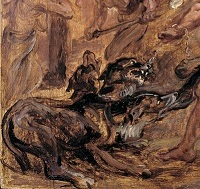 Cerberus
Cerberus is a three headed dog
with the tail of a serpent. Guardian of the underworld, the dog keeps over the
underworld, and by having an appetite for only living meat, Cerberus keeps the dead
from escaping and the living from entering. In the
Cerberus, the hero Orphesus puts
Cerberus to sleep with music to ensure passage into the underworld. Cerberus also
appears throughout Roman mythology.
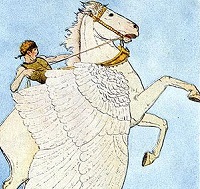
The celestial
stallion
Pegasus was sent to
fetch lighting and thunder for the god Zeus. Beyond Greek mythology, the figure of a
winged, white horse is a recognizable symbol throughout modern, cross cultural
iconography. As a character, he's been reimagined in stories young and old. Most
popularly, he is a revisioned by disney in the movie
Herculues.
Languages:
Ancient Greek, Ancient Macedonian, Modern Greek, Tsakonian
The Indo-Iranian
Branch
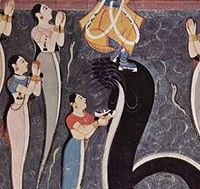
"
Nāga" is the Sanskrit word for
an entity which takes the form of a serpent, though sometimes it may be used
generally as simply "cobra" or "snake" The typical Sanskrit for snake is "sarpa,"
and in Hindi and Marathi, languages spoken today, the word is "sarp." Nagas are
prominent characters through the Sanskrit epic,
Mahabharata, and are often
villains though occasionally benevolent. "Nāginī" is the female word for
"Nāga."

An ancient analogue
of the phoneix and a parallel of the Persian Simurgh, the
Garuda is a grand and benevolent
Hindu divinity. In the
Mahabharata, he bursts from a fiery egg with enough power the end the world
and plunge all life into a new age. He is the traditional enemy of the Nāga. Garuda
appears in other ancient Indian texts including the
Vedas and the
Bhagavad-Gita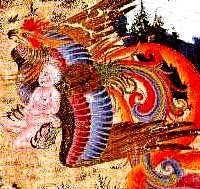
In ancient
Iranian stories, the
simurgh is a
divine, female eagle, and so ancient, legend says, that she possesses all knowledge
from all time. One story recounts that the simurgh dies and remerges from fire every
1,000. The simurgh has analogues across time and cultures. Ferdowsi
Shahnameh
is a Iranian epic still read and loved by Persians today. In the story, the Simurgh
rescues and raises an abandoned prince. Analogues of the Simurgh, for instance, the
phonex, exist across time and cultures.
Languages: Avestan, Old Persian,
Middle Persian, Farsi, Dari, Pashto, Balochi, Sanskrit, Hindi, Marathi, Bengali,
Assamese, Punjabi, Nepali, Romani
The Italic
Branch
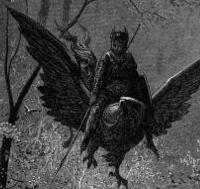
The
Hippogriff is mythological
figure that appears throughout European literature. Analogus to Pegasus and the
Griffen in several ways, it has the front body a giant eagle and the back body of a
winged horse. It is depicted as swift and benevolent, the mount of valiant knights
and sorcerers
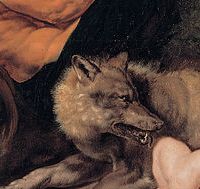
In Roman mythology,
Romulus and Remus
are born illegitemately to the gods and are left as infants to be raised by a wolf.
The boys realize their heritage later in life and become founders of Rome.
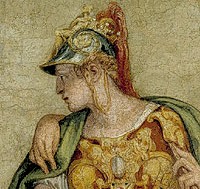 Minerva
Minerva was the Roman goddess of
war, the arts, and, most predominantly, wisdom. Her name is derived from the
Pro-Indo-European root, "men-," which relates to the modern English word "mind.
Minerva's influence as a symbol and icon went beyond the Roman empire, throughout
Europe and even as far as Britain.
Languages:
Latin, French, Italian, Sicilian, Spanish, Portuguese
The Celtic
Branch
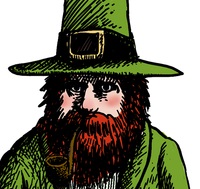
In Irish
folkore,
leprechauns are fairy
like creatures who hoard gold. They are associated with magic and mischief. If
caught by a human, myths say they are obliged to grant their capturer three
wishes.
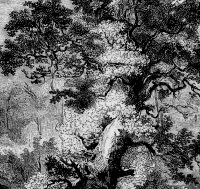
In celtic mythology,
sacred trees are
envisioned as refugees for fairies and other mythological spirits. They possess
supernatural powers. For instance, elder trees are often imagined to be haunted. Yew
is associated with immortality.
Languages:
Welsh, Irish, Scottish Gaelic
The Germanic
Branch
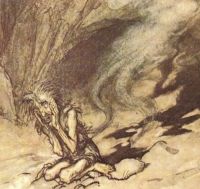
A
cloak of invisibility is a common element in European folklore. There are
notable mentions of it in English, Welsh, German, and other cultural literature. The
German opera
Das Rheingold
features shows a cloak as shown in this illustration by
Arthur Rackham.
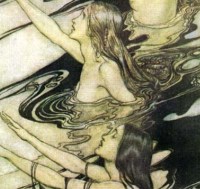
The German
Nixie is analogous
to a mermaid. A shapeshifting water spirit, these entities exist in Germanic and
also Nowegian and Scandinavian folklore. Particularly in German literature, this
figure is often conceptualized as a sprite who lures people into water with dubious
intentions.
Languages:
Dutch, Swedish, Norwegian, German, English, Danish, Scots, Icelandic
The Armenian
Branch

"Vishap" is
an Armenian word for "dragon" or "serpent." The
image depicts a vishap stone.
Sources describe how in Armenian mythology, these creatures are thought to
originate from the mountains. They are associated with fire, wickedness, and also
keen intelligence.
Languages:
Old Armenian, Middle Armenian, Armenian
The Baltic
Branch
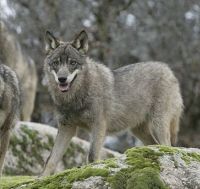
The
Iron Wolf appears
in the Lithuanian myth regarding the founding of
Vilnius, the country's capital
today. The legend goes that a Duke was on a hunt and went to sleep in the woods for
the night. He dreamt of a wolf howling as if there were thousands. Upon awakening,
he determined the wolf represented a castle, and he was being calle upon to build
Vilnius. Wolves are common figures across all types of mythology throughout Europe.
Languages:
Latvian, Lithuanian
The Slavic
Branch
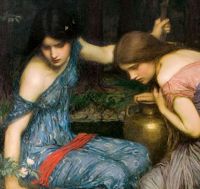
The illustration is
of European nymphs. Analogous to these entities,
veela, or
samodiva, or
lele in Romania
are Slavic woodland fairies, often depicted as pale, celestial maidens. Upon being angered, however,
they can turn into ferocious birds. They are associated with fire and vindictiveness.
Languages:
Old East Slavic, Old Church Slavonic, Russian, Czech, Slovak, Polish, Bulgarian,
Ukrainian, Slovenian
The Albanian
Branch
 The Tale of the
Eagle
The Tale of the
Eagle is an origin tale of the Albanian people. It recalls how an eagle
mistakenly offers an undead serpent to her eaglet. A young man sees and kills the
serpent with his bow. Having saved the eaglet, the young boy takes him away as a
prize. Distraught, the eaglet's mother promises her power, cunning, and name to the
boy if he returns her child. The young boy agrees and his kingdom became known as
the
Land of the Eagles.
Languages:
Albanian
 This is an illustration from
Al-Qazwīnī’s Ajā’īb al-makhlūqāt wa gharā’ib al-mawjūdāt, a Persian translation
published in 19th century India. A centaur named Firenze eludes to Voldemort's return in
Book 1, Harry Potter and the Sorcerer's Stone.
This is an illustration from
Al-Qazwīnī’s Ajā’īb al-makhlūqāt wa gharā’ib al-mawjūdāt, a Persian translation
published in 19th century India. A centaur named Firenze eludes to Voldemort's return in
Book 1, Harry Potter and the Sorcerer's Stone.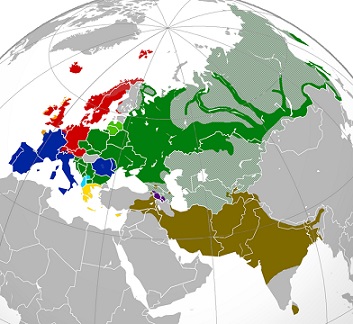

 The celestial
stallion
The celestial
stallion  "
" An ancient analogue
of the phoneix and a parallel of the Persian Simurgh, the
An ancient analogue
of the phoneix and a parallel of the Persian Simurgh, the  In ancient
Iranian stories, the
In ancient
Iranian stories, the  The
The  In Roman mythology,
In Roman mythology,

 In Irish
folkore,
In Irish
folkore,  In celtic mythology,
In celtic mythology,
 A
A  The German
The German  "Vishap" is
an Armenian word for "dragon" or "serpent." The
"Vishap" is
an Armenian word for "dragon" or "serpent." The 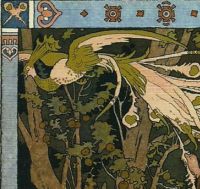 Folklorist
Folklorist  The illustration is
of European nymphs. Analogous to these entities,
The illustration is
of European nymphs. Analogous to these entities, 